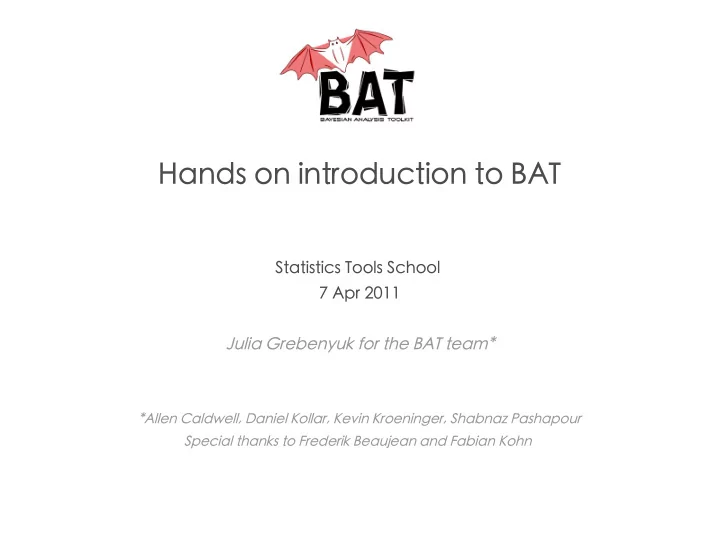

Hands on introduction to BAT Statistics Tools School 7 Apr 2011 Julia Grebenyuk for the BAT team* *Allen Caldwell, Daniel Kollar, Kevin Kroeninger, Shabnaz Pashapour Special thanks to Frederik Beaujean and Fabian Kohn
Tutorial on radioactive decay rate Goal: learn how to use BAT on a simple example Let's consider measuring the decay rate of a radioactive isotope in presence ● of background Two measurements: ● One without radioactive source to measure background ● One with the source ● Duration: T = 100s each ● N 1 = 100 – number of background counts only – N 2 = 110 – number of counts including the source –
Decay rate Decay rate of the isotope: Total rate = signal rate + background rate: R=R S +R B Measured for the time T, observed N 1 and N 2 events Assume R=R S +R B constant Lear earn abou n about pr t probable v obable valu alues of es of R R S B Bay ayes' es' T Theor heorem em
Bayes' Theorem Posterior ~ Likelihood x Prior Number of events N, in a time T follows a Poisson distribution → the probability of the data (likelihood) is:
Prior Simplest choice: flat prior in a box
Combining the measurements 1. Estimate R B using the first measurement, then add second measurement and estimate R s and R B 2. Use both measurements together
Results using the first measurement R B obtained using background measurement only
Results using two measurements R B and R s obtained using two measurements
Where to find the tutorial BAT homepage: http://www.mppmu.mpg.de/bat/ Navigate to: Documentation → Tutorials → Counting experiment Direct link: http://www.mppmu.mpg.de/bat/?page=tutorials&name=counting_experiment
Steps Step 1 - Compiling your first BAT program Step 2 - Fitting the background-only model Step 3 - Including the signal contribution Step 4 – Further steps
Step 1: create the project → On your Virtual Machine go to: /statistics-school/BAT-0.4.2/ → Navigate to tools subdirectory → Run the script CreateProject.sh to create a project named CountingExp → Have a look at the generated C++ classes and compile the code with make Information about the data sets and details of the run goes in runCountingExp.cxx Information about the model and prior goes in CountingExp.cxx
Step 1: create the project → On your Virtual Machine go to: /statistics-school/BAT-0.4.2/ → Navigate to tools subdirectory → Run the script CreateProject.sh to create a project named CountingExp → Have a look at the generated C++ classes and compile the code with make Information about the data sets and details of the run goes in runCountingExp.cxx Information about the model and prior goes in CountingExp.cxx
Step 2: Fitting background-only model → Create a data point, add it to a data set and register the data set with the model → Define the parameter R B and add it to the model → Define the log likelihood for the Poisson process with parameter R B . The natural logarithm of the factorial is provided by BCMath::LogFact(int n). One can also use the approximation provided by BCMath::ApproxLogFact(int n) which is much faster for large numbers. → Use a flat prior for R B → Start to sample from the posterior using the Markov chain → Find the mode of the posterior → Save the results of the fit in text form and create a plot of the (marginal) posterior distribution
Step 3: Include the second measurement → Add a second data point, N 2 , to the data set → Include the second parameter R S with flat prior in the model → Update the likelihood to incorporate N 2 and R S → Plot the marginal distributions and compare the values of mean, median and mode for the individual parameters. What is the correlation between R B and R S ? → Extract the 95% limit on R S and save the plot
Step 4: Further steps → Redo step 2 and 3. Save P(R B |N 1 ) and P(R B |N 1 ,N 2 ) as a ROOT TH1D histogram. Limit R B to the range [0,2] and use more bins (500 instead of the default 100) to store the marginalized distribution. → Normalize and plot the two histograms. → Measure the time it takes to run the program. → Modify LogAPrioriProbability to do nothing else than returning zero. This amounts to setting the prior to 1. Compare execution time. → Multiplying the likelihood by a constant just affects the normalization, but not the values of mode, mean... Thus remove all terms that are added to LogLikelihood and which are independent of R B , R S . You should observe that running the program takes only about a quarter of the time compared to 3. → Redo step 2, but now use the Reference prior (=Jeffrey's prior here) for R B which reads P(R B )∝1/√R B . Does the posterior P(R B |N 1 ) change significantly?
Recommend
More recommend